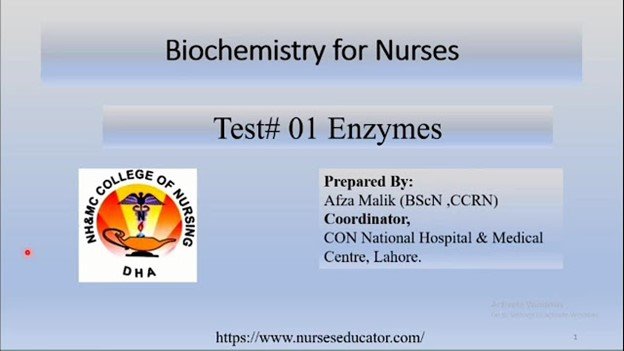A detailed description Enzymes Co-Enzymes and MCQs Basic concept about enzyme and co-enzymes includes activation energy, holoenzyme, apo-enzyme, co-factors and metal ions.
What are Enzymes Co-Enzymes and MCQs
Basic and introductory overview to Enzymes Co-Enzymes along with their MCQs Link.
Enzymes and Substrates
Enzymes , Co-Enzymes and MCQ: Enzymes are another important group of biomolecules synthesized by living cells. They are catalysts of biological systems (hence are called biocatalysts), colloidal, thermolabile and protein in nature. They are remarkable molecular devices that determine the pattern of chemical transformations.
They also mediate the transformation of different forms of energy. The striking characteristics of enzymes are their catalytic power and specificity. Actions of most enzymes are under strict regulation in a variety of ways. Substances on which enzymes act to convert them into products are called substrates.
What is Activation Energy
Catalytic Activity of Enzymes: Enzymes have immense catalytic power and accelerate reactions at least a million times, by reducing the energy of activation . Before a chemical reaction can occur, the reacting molecules are required to gain a minimum amount of energy, this is called the energy of activation . It can be decreased by increasing the temperature of the reaction medium. But in human body which maintains a normal body temperature fairly constant, it is achieved by enzymes.
Holoenzyme , Apoenzyme and Co-Enzymes
Protein Nature of Enzymes: In general with the exception of ribozymes which are few RNA molecules with enzymatic activity, all the enzymes are protein in nature with large mol. wt. Few enzymes are simple proteins while some are conjugated proteins. In such enzymes the non-protein part is called prosthetic group or coenzyme and the protein part is called as apoenzyme . The complete structure of apoenzyme and prosthetic group is called as holoenzyme.
Holoenzymes = Apoenzymes (Protein part) + Coenzymes (Prosthetic group)
Protein chains in enzymes
Enzymes , Co-Enzymes and MCQ: Certain enzymes with only one polypeptide chain in their structure are called as monomeric enzymes , e. g. ribonuclease . Several enzymes possess more than one polypeptide chain and are called as oligomeric enzymes , eg lactate dehydrogenase, hexokinase, etc. Each single polypeptide chain of oligomeric enzymes is called as subunit .
When many different enzyme catalysing reaction sites are located at different sites of the same macromolecule, it is called as multienzyme complex . The complex becomes inactive when it is fractionated into smaller units each bearing individual enzyme activity, eg fatty acid synthetase, carbamoyl phosphate synthetase II,pyruvate dehydrogenase, prostaglandin synthase, etc.
Coenzymes
Certain enzymes require a specific, thermostable, low mole. w t , non-protein organic substance called as coenzyme . A coenzyme may bind covalently or noncovalently to the apoenzyme. The term prosthetic group denotes a covalently bonded enzyme. It is generally observed that reactions involving oxidoreductions, group transfers, isomerization and covalent bond formation require coenzyme .
Since the involvement of coenzyme in a given reaction on a substrate is so intimate that coenzyme is often called as cosubstrate or second substrate. Many coenzymes are derived as the physiologically active forms from the constituents of vitamin B-complex viz, Pantothenic acid: CoASH , Vitamin B12: Cobamide , Folic Acid: Tetrahydrofolate (F.H4), Niacin: NAD+, NADP, Riboflavin: FMN, FAD , Pyridoxine: Pyridoxal phosphate, Thiamine: TPP.
Classification of Coenzymes
Coenzymes can be classified according to the group whose transfer they facilitate . Based on this concept we may classify coenzymes as follows:
1:For transfer of groups other than hydrogen
2:For transfer of hydrogen
NAD+, NADP+,FMN, FAD,Lipoic acid and Coenzyme Q.
In addition heme acts as coenzyme in cytochromes, peroxidases and PG synthase complex. Many coenzymes contain adenine, ribose and phosphate and are derivatives of adenosine monophosphate (AMP) such as NAD, FAD.
Role of metal ions in enzymes
The activity of many enzymes depends on the presence of certain metal ions such as K+, Mg++, Ca++, Zn++, Cu++.
1:Metal activated enzymes: In certain enzymes the metals form a loose and easily dissociable complex. Such enzymes are called metal-activated enzymes .The metal ions can be removed by dialysis or any other such method from the enzyme without causing any
denaturation of apoenzyme.
2:Metalloenzymes: The second category of metal enzymes is called as metalloenzymes . In this case metal ion is bound tightly to the enzyme and is not dissociated even after several extensive steps of purification.
For MCQs Practice Link Given Below
Reference: Notes Made By The Help of “The Text Book of Medical Biochemistry By MN. Chatterjea 8th Edition”
Read More:
https://nurseseducator.com/didactic-and-dialectic-teaching-rationale-for-team-based-learning/
https://nurseseducator.com/high-fidelity-simulation-use-in-nursing-education/
First NCLEX Exam Center In Pakistan From Lahore (Mall of Lahore) to the Global Nursing
Categories of Journals: W, X, Y and Z Category Journal In Nursing Education
AI in Healthcare Content Creation: A Double-Edged Sword and Scary
Social Links:
https://www.facebook.com/nurseseducator/
https://www.instagram.com/nurseseducator/

